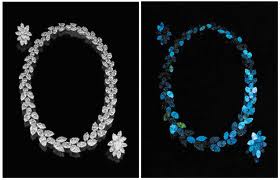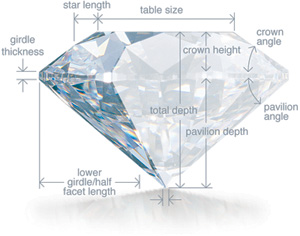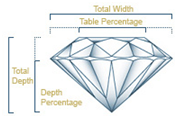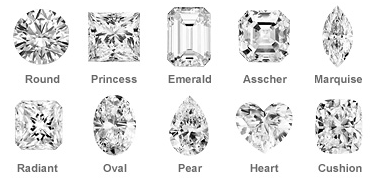4C's
| Origin of the Diamond 4Cs |
|
4Cs of Diamond Quality
Every diamond is a miracle of time and place and chance. Like snowflakes, no two are exactly alike. Until the middle of the twentieth century, there was no agreed-upon standard by which diamonds could be judged. GIA created the first, and now globally accepted standard for describing diamonds: Color, Clarity, Cut, and Carat Weight. Today, the 4Cs of Diamond Quality is the universal method for assessing the quality of any diamond, anywhere in the world. The creation of the Diamond 4Cs meant two very important things: diamond quality could be communicated in a universal language, and diamond customers could now know exactly what they were about to purchase. |
The formation of a diamond is not a gentle process. Most diamonds are born in extreme circumstances from primeval carbon deep in the earth’s mantle at about 500,000 to 2 million feet below the surface. They are then shot up to the surface at supersonic speeds by eruptions inside the earth. The magma originates much deeper, which is what enables the diamonds to be extracted and carried up through the earth. The extreme heat and pressure that diamonds undergo during their ascent can cause unique “birthmarks” that affect their clarity. These are referred to as inclusions when they are internal or blemishes when they appear on the diamond’s surface.
The HKD Diamond Report comes with a diagram indicating the characteristics of your diamond, including any inclusions or blemishes your diamond may have and where they appear. The most important thing to remember when it comes to clarity is that a diamond’s inclusions and blemishes should not be noticeable to the naked eye, nor should they be so excessive that they affect the diamond’s durability. We grade a diamond’s clarity according to the GIA International Diamond Grading System. The GIA Clarity Scale has a range of 11 grades that run from flawless (FL) to obvious inclusions (I3). A diamond that is higher up on the Clarity Scale will be more brilliant – and with all other characteristics being equal, more valuable – because it doesn’t have inclusions and/or blemishes that impede its ability to refract and reflect light. Clarity Grading Scale 
GRADE DESCRIPTION FL (Flawless) - Flawless diamonds show no inclusions or blemishes of any kind when examined under 10X magnification by a skilled grader. IF (Internally Flawless) – Internally Flawless diamonds has no inclusions when examined under 10X magnification by an experienced grader, but will have some minor blemishes like surface grain lines, naturals and extra facets. VVS1 & VVS2 (Very, Very Slightly Included) - VVS diamonds contains minute inclusions that are difficult even for an experienced grader to see under 10X magnification. VS1 & VS2 (Very Slightly Included) - VS diamonds contain small or minor inclusions such as small crystals, clouds or feathers when observed with effort under 10X magnification. SI1 & SI2 (Slightly Included) – SI diamonds contain inclusions are noticeable under 10x magnification to an experienced grader and may or may not be visible to the naked eye. However, when set in jewelry, the inclusions may become less visible. I1, I2 & I3 (Included) – I diamonds contain inclusions that are obvious under 10x magnification and are usually visible to the naked eye.
“Colorless” or “white” diamonds – the diamonds traditionally used for engagement rings, stud earrings and solitaire pendants – are evaluated on a color-grading scale developed by the GIA. It spans the alphabet from D to Z with D being colorless, and Z representing a light yellow tint. With colorless diamonds, the value is placed on how little color you can see, and this is determined by studying the diamond under controlled lighting and comparing it to the HKD’s color scale. Incidentally, D-grade diamonds – i.e. truly colorless diamonds – are extremely rare and valuable.
HKD Color Range Diamonds with a color grade of D, E or F are considered colorless. Diamonds graded G, H, I and J are near colorless. Diamonds that fall in the K, L and M color grade range have a faint yellow tint. Diamonds in the N, O, P, Q and R range have a very light yellow tint and S to Z is light yellow. 
Fancy Color Diamonds While “colorless” diamonds are the most popular, they are just one category of diamonds. The other category of natural stones is known as “fancy color diamonds.” Although relatively rare, they have been found in every color of the spectrum. Some of the most famous fancy color diamonds include The Hope Diamond (a walnut-sized blue diamond), The Hancock Red, and The Dresden Green (the largest green diamond ever found). Fancy color diamonds are not graded on the same color scale as “colorless” or “white” diamonds. Rather, their value is derived by color intensity that ranges from Light at the lower end to Vivid at the high end. The more intense or strong the color appears, the more valuable the diamond. Color intensity is the most important factor when purchasing a fancy color diamond. The distinct difference between fancy color diamonds and other colorful gemstones such as rubies, sapphires, and emeralds is in the mineral makeup. In particular, it’s the presence of carbon that differentiates fancy color diamonds from other colored gemstones. All natural color diamonds are graded by HKD Diamond Laboratories under controlled lighting environments similar to that of natural daylight. Diamonds are also tested for treatment, synthetic additions or alterations to ensure their authenticity. 
Fluorescence When exposed to ultraviolet light, a small percentage of diamond fluoresces, or emits a blue or yellow light. Fluorescence is caused by trace elements, usually boron, which seeps into the diamond when it is created. 

A diamond’s cut is the most critical of the 4Cs because it’s what gives the diamond its brilliance, sparkle, and fire – the diamond’s three main attributes. When people talk about “brilliance,” they are referring to the amount of light a diamond reflects. “Fire” describes the way the light disperses and how the diamond shows off the different colors of the spectrum. “Sparkle” – also known as “scintillation” – defines how much the diamond shimmers when you move it around in the light. When light enters the diamond, it is refracted and bounces back out in a rainbow of colors.
The way a diamond is cut will have the biggest effect on how the stone catches and interacts with light. It is the ultimate expression of a craftsman’s skill in transforming a rough diamond into a breathtaking gem. If the diamond is too shallow and not cut right, some of the light will be lost out of the bottom. One that is cut too deeply will lose light out the side of its base. An Ideal Cut diamond will reflect most of the light through their table or top surface. 
Proportion An Ideal cut has a specific set of guidelines defining the proportions that give a diamond the highest level of fire and brilliance. It takes into account the relationship between the table size, crown angle, pavilion angle, girdle, crown depth and pavilion depth. It evaluates the following:

It’s important to note that the cut depends on the stone’s shape while it does not describe the shape. The most popular shape is the Round Brilliant diamond that is cut with 57 facets. When the culet is flattened into a facet, a round diamond will have 58 facets. Other shapes are usually referred to as “fancy shapes,” and include Princess, Emerald, Asscher, Marquise, Oval, Radiant, Pear, Heart and Cushion. Each diamond shape has its own set of guidelines that determine the quality level of its cut. Symmetry HKD Diamond Reports also rate the overall symmetry of the diamond’s facets and how well facet edges align with each other, how corresponding facets from opposite sides of the diamond align with each other and the relationship between crown facets and pavilion facets.
A carat (ct.) is the unit of measurement specifically used to describe the weight of a diamond (or other gemstones). Its name comes from the carob seed – a small seed with a typically uniform weight that early gem traders used as counterweights for balancing their scales, according to the GIA. A single carat is equivalent to 0.2 grams, or 200 milligrams, and is divided into 100 points. AA certified diamond that comes with a grading report will indicate the exact carat weight to the nearest hundredth of a carat, in decimal format. A 1-carat diamond has 100 points (1.00) while a ¾ carat stone has 75 points (0.75). Carat weight in pre-set jewelry is typically described as a fraction (e.g. ¾ carats) and has an equivalent decimal range (¾ carats = 0.69 – 0.82 points). The following table correlates fractional sizes with their decimal equivalent:
CARAT FRACTIONS DECIMAL EQUIVALENT 1/10=.09 – .11 1/8=.12 – .13 1/7=.14 – .15 1/6=.16 – .17 1/5=.18 – .22 1/4=.23 – .28 1/3=.29 – .36 3/8=.37 – .44 1/2=.45 – .58 5/8=.59 – .68 3/4=.69 – .82 7/8=.83 – .94 1.0=.95 – 1.05 The carat is probably the most familiar of the 4C terms because it is the easiest one to understand just by looking at the stone. However, people often mistakenly assume that a diamond’s size is synonymous with its weight, though that’s not necessarily true. The way a diamond is cut can actually obscure its size and true weight. The following diagram shows the relative size of carat weights for a diamond that is cut to the same proportions. Note: Diamond illustrations show relative size, not actual size. Carat Weight Scale 
It’s important to note that it’s not just the carat weight, but also the quality of the stone at that weight that helps determine the diamond’s value. Factors that determine quality include the cut, color, clarity, and finish. One exceptionally high-quality diamond can sell for $20,000 per carat while a lower-quality one sells for just $1000 per carat. Diamond values also increase disproportionately to the size of the stone, since larger diamonds are rarer. In other words, a three-carat stone with equal color, clarity, and cut can end up costing significantly more than three times the cost of a one-carat stone.
Since your diamond is a valuable investment, you’ll want to take proper care of it. This section contains some basic tips to help keep your diamond looking its best.
Diamond Care Do’s Diamonds must be kept clean and stored carefully when they are not being worn. Here are some guidelines to help keep your diamond in top condition: If you notice loose stone settings or any other noticeable damages to your jewelry, do not continue to wear the jewelry. Take it to a trusted, professional jeweler who can make an assessment and repair the jewelry. We recommend that you have a jeweler check the setting in your diamond ring, stud earrings or solitaire pendants (while you watch) once a year. When you’re not wearing your diamonds, be sure to store them in a fabric-lined case or in a box with dividers to prevent the diamonds from scratching other jewelry or other diamonds. Diamond Care Don’ts Avoid wearing your diamonds while doing housework, yard work or any other kind of rough work. Even though a diamond is extremely durable, a hard blow could chip it. When doing household chores, never allow your jewelry to come into contact with chlorine bleach. Cleaning Your Diamonds Diamonds, like anything else, get smudged, soiled and dusty. Lotions, powders, soaps–even the natural oils from your skin–will create a film on diamonds, which will reduce their brilliance. In addition, chemicals in the air will oxidize or discolor the mountings. Keeping your jewelry clean will maximize its brilliance. Here are some of the ways you can clean your diamonds: Detergent Bath: Prepare a small bowl of warm suds using any mild household liquid detergent (be sure not to use any cleaners containing chlorine). Brush the jewelry with a soft brush until you have created lather around it. With the jewelry on a plastic or metal strainer, rinse off with warm water (be sure not to clean your jewelry over the drain!) Pat your jewelry dry with a soft, lint-free cloth. Cold Water Soak: Make a solution of 4 parts cold-water and 1 part very mild dishwashing detergent. Soak the pieces for several minutes. Lift out and tap gently around all sides of the mounting with a soft brush. Rinse the pieces in the solution once more and drain on tissue paper. Quick-Dip Method: Buy one of the brand name liquid jewelry cleaners, choosing the one that is best for the kind of stones and metals in your jewelry. Read the label carefully and follow the instructions. Do not touch your clean diamonds with your fingers, as the oils from your hands will leave a film on the stone. The Ultrasonic Cleaner: There are many types of these small machines available to the public today. They will clean any piece of jewelry that can be soaked in a liquid within a matter of minutes. These machines often have a metal cup, which is filled with water and detergent. When the machine is turned on, high-frequency turbulence is created. Traveling with Diamonds Packing your precious diamond jewelry for traveling should be done with utmost care. There are many types of jewelry carrying cases that are specifically designed for jewelry travel, available in all price ranges, sizes, shapes and patterns. Most have velvet pads inside to attach pins and earrings, with special compartments for bracelets and necklaces. Don’t ever leave your jewelry on the rim of a sink when you remove it to wash your hands. It can very easily slip down the drain. When you’re away from home, don’t take off your jewelry in a public place–you may accidentally forget it and lose it forever.
In 2000, the world adopted the Kimberley Process, a UN-Mandated process that assures customers that 99% of diamonds are sourced free of conflict.
What are conflict diamonds? Conflict diamonds, also known as “blood” diamonds, are diamonds whose profit is used to finance illegal operations of rebel, military or terrorist’s movements or their allies, aimed at overtaking legitimate government. What areas of the world are affected by conflict diamonds? The fighting that is fueled by the trade of conflict diamonds has been relegated to few Central and West African countries, including Sierra Leone, Angola, The Democratic Republic of Congo, and Liberia. What has the diamond industry done about conflict diamonds? The global diamond industry created the Kimberly Process to ensure that conflict diamonds are kept out of the retail market. What is the Kimberley Process? The Kimberley Process is a UN mandated international certification scheme aimed to prevent the trade of conflict diamonds while helping to protect the legitimate trade of rough diamonds. The Kimberly Process Certification Scheme (KPCS) outlines the provisions by which the trade of rough diamonds is to occur.
The most important factors in choosing a diamond stone is deciding on the shape that perfectly matches your style and looks beautiful on you. Your style may guide you to more traditional shapes such as the classic Round, Emerald or Asscher cuts or fancy shapes such as the Marquise, Heart or Pear.

The classic and most popular shape is the Round Brilliant Cut diamond. Its 57 facets bring out the most brilliance, fire and sparkle of all the shapes. If you’re looking for more contemporary style, consider the Princess Cut, the second most popular shape. Princess cut diamonds are square or slightly rectangular in shape with pointed corners and an array of intricate facets that increase the diamond’s inherent sparkle. For a timeless, elegant look, consider the Emerald Cut diamond with its long, lean lines. The rectangular cut, which has a relatively larger open table (top, flat surface) and fewer facets, highlights the clarity of the diamond more than any other shape. The striking Asscher Cut, often described as a square emerald, evokes an art deco feel from the 1920s and ‘30s. Created at the turn of the 20th century, this shape is now experiencing resurgence in popularity. The Radiant Cut is relatively scarce and appeals to those seeking a unique look. This cut combines the geometrical lines of the emerald shape with the sparkling brilliance of the round cut. Its trimmed corners are the signature characteristic of this shape. As with Asscher-cut diamonds, the Cushion Cut has been popular for more than a century. With a soft and romantic look, the Cushion-cut (or “pillow-cut” as it is often referred to as) has rounded corners and larger facets to increase the stone’s brilliance. The Marquise Brilliant Cut diamond delivers drama with its brilliant cut and tapered points at two ends. This diamond, when worn as a ring, creates an elongated, slender look. Cleverly, it also maximizes carat weight, giving the appearance of a larger diamond than a round diamond of the same carat weight. The Pear Brilliant Cut shaped diamond resembles a glistening teardrop that combines the soft, rounded end of an Oval shape with the sharp, tapered point of a Marquise-cut. An interesting choice for the multi-faceted personality. The Oval Brilliant Cut shaped diamonds appeal to those who like their classics with a little edge. Similarly to a classic round diamond, oval diamonds deliver a beautiful brilliance. The elongated shape adds an interesting twist to rings and accentuates the hand to create a slender look. The fancy-shaped Heart Brilliant Cut diamond is for the confident woman who is all heart. While sometimes selected for engagement rings, it makes a beautiful choice for pendants in fancy colors such as yellow, pink or red. |
Verify Your Diamond Grading Reports!
Copyright © 2024 HKDLab. All rights reserved.


